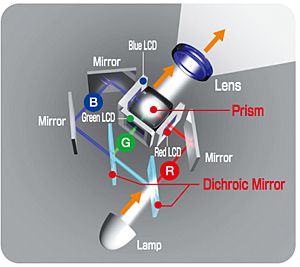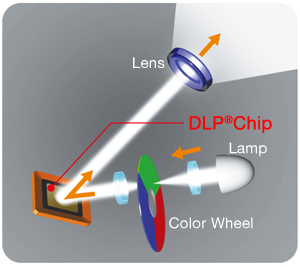Please note that JavaScript and style sheet are used in this website,
Due to unadaptability of the style sheet with the browser used in your computer, pages may not look as original.
Even in such a case, however, the contents can be used safely.
TechnologyWORDS : Projector
| LCD(liquid crystal display) Projector | This is a projection method using the LCD panel. Three pieces of the LCD panel are used in a projector in general. Light emitted from the light source lamp is divided into the three primary colors of R (red), G (green), and B (blue) with the dichroic mirror. The divided lights are respectively transmitted through three pieces of the LCD panel handling each color individually. Then the light of these three primary colors is synthesized with a prism and projected on a screen through the lens.
|
|---|---|
| Digital Light Processing | DLP stands for Digital Light Processing. This is a projection method using the DLP® chip. In case of the single chip configuration, light emitted from the light source is divided into the three primary colors of R (red), G (green), and B (blue) by the time axis with the color wheel turning at high speed. These lights are reflected on the DLP® chip and projected on a screen through the lens. In the case of the three-chip configuration, a focused beam emitted from the light source is collimated (parallel beam) through the integrator and then divided into the three primary colors of R (red), G (green), and B (blue). These lights are irradiated to the DLP® chip. Colors of the modulated lights are synthesized with the color prism and then enlarged with the projection lens.
|
| DLP device chip | This is the display device for the DLP® projector. Several hundreds of thousands of micro mirrors are turned on and off repeatedly to reflect light. |
| Luminance | This indicates the brightness of images on a screen. Since the brightness of images varies slightly with the position, the screen is divided into 9 portions, and the brightness of the respective portions are measured independently and then expressed as the average value in units of lumens. |
| Lumen | This is the unit of brightness for images on a screen. The projected images are divided into 9 portions and then the brightness of the respective portions are measured independently. This is the unit of their averaged value. Larger values mean the brighter images. |
| Aspect Ratio | This is the ratio of the length and breadth of a monitor screen or an image displayed on a monitor. The ratio for current terrestrial TV broadcasting is 4:3, while the same for hi-vision is 16:9. |
| Contrast Ratio | This is a difference between brightness and darkness projecting black and white on a screen. Larger values indicate that images have superior gradations and become clearer. |
| Gray Scale | This indicates gradation steps between the brightest white and the darkest black. A greater number of gradations (multi gradation) means richer expression capabilities. |
| Jaggy | This means an uneven state. This is a phenomenon where the characters, curves, and inclined lines drawn with dots appear unevenly like stairs. |
| 3-2 pull down | This is a method to be used for converting film images into video signals. Video signals for TV broadcasting are composed of units at 30 frames per second, and cinema films are composed of units at 24 frames per second. With this method, a unit at 24 frames per second can be divided again into a unit at 30 frames per second by outputting images according to the time axis. This is also referred to as the 2-3 pull down. |
| Poli-Silicon TFT | This is a kind of TFT LCD panel. Poly-silicon is employed instead of the silicon in the amorphous state that is used for an ordinary TFT panel. Since the poly-silicon is more conductive than the amorphous silicon, the response time of the liquid crystal is faster. Furthermore, the size of the transistor controlling the liquid crystal can be reduced, opening of the liquid crystal becomes larger, and the brightness can be improved. |
| Micro Lenz Array | This is an aggregate of extremely small lenses of micron size. By installing this on the LCD panel, the efficiency of light can be improved and then the brightness is also improved. |
| 3 primary color LCD shutter projection method | This is a method where light is divided into the three colors of red, green, and blue, and then the divided lights are assigned to three pieces of the LCD panel, respectively. Since the amount of information about the colors is large and the accuracy of the reproduced colors is high, the color reproduction capability can be improved. |
| Dot | This means a dot composing an image. The number of dots indicate how many dots are used for composing an image. It is expressed as a product of dots arrayed in the vertical direction and the horizontal direction. |
| Resolution | This is the amount of information indicated with the number of dots in the length and breadth. For instance, 800 x 600 dots is referred to as SVGA, 1024 x 768 dots is XGA, 1028 x 1024 dots is SXGA, and 1600 x 1200 dots is UXGA, respectively |
| Digital Visual Interface | This is one of the interface standards for connecting the computer and the LCD. Recently many projectors are equipped with this interface. Since information about the three primary colors of light, namely R (red), G (green), and B (blue), is transmitted as digital signals, the signals deteriorate less, and it is possible to output with high quality. For the standards of terminals, DVI-D dedicated for digital signals and DVI-I supporting analog RGB as well as digital signals are available. |
| Internet protocol exchange | This means to convert the interlaced image reproducing a single image with two skipped images into a single complete progressive image. |
| Thin films transistors method LCD | This stands for the Thin Film Transistor Liquid Crystal. This is a liquid crystal that drives a single dot with a single transistor. Since it is possible to execute appropriate switching operations according to the signals, it is possible to reproduce images of higher quality than the simple matrix liquid crystal without TFT. |
| Lens coating treatment | This is a mirror where a film of special optical materials is coated on a glass so that light with a certain wavelength is transmitted through while other wavelengths are reflected. This is used in the LCD type (3LCD) projector as a filter dividing light into the three colors of RGB. In the case of the projector, the dichroic mirror reflecting red extracts only the red element from the light from the light source at first. Then the green element is extracted from the transmitted light with the dichroic mirror reflecting the green color. Then the light transmitted through is only blue. These three colors of lights are transmitted through the liquid crystals supporting the respective colors and synthesized with a prism to obtain images in full color. |
| Prism | This is a component that synthesizes the light of the three primary colors incoming separately. |
| Projection angle for screen | This is the angle that the projector projects images onto the screen. |
| Keystone Correction | This is a phenomenon where the projected image becomes a trapezoid shape instead of a square since the projector is tilted to longitudinal direction from the proper angle to the screen. This phenomenon may also occur for inclination in the latitudinal direction. |
| Lens Shift | This is a convenient function to move the position of the projected image vertically by moving the optical axis of the lens. |
| Throwing Distance | This is the distance from the lens of the projector to the screen. If the size of the screen becomes larger, the throwing distance becomes longer. |
| Gamma Correction | This is a compensation operation materializing more natural gradation by adjusting the correlation between the color data of images and the signal for outputting the color. |
| Screen gain | This indicates the reflection efficiency of a screen. If it is possible to reflect light with the same brightness as the projected light, the screen has a gain of 1. |
| Screen size | The size of a screen is expressed in the length (inch) of its diagonal. In Japan, the unit of "KATA" is generally used instead of the unit of inches. On the same projector, if the size of the screen to which images are projected becomes larger, the brightness of the images becomes darker in inverse proportion to the screen size. |
| Gray Level | A brightness between the highest brightness and the lowest brightness. The gray scale means the number of steps of neutral tones. |
| Digital Cinema | This is a system where the digital equipment is entirely used for shooting, editing, and screening movies. |
| D-Sub Mini 15pin | This is a multi-pin terminal connecting a PC and a data projector. Recently a multi-pin terminal for AV D-terminal similar to this terminal has been put into the market. However, the D-terminal is the standard available in the domestic market only. It has an advantage that a lot of information can be exchanged through a single connector. |
| Picture like a real | This means that the respective kinds of video format are displayed as they are without compressing or converting its number of dots. |
| Compression display | If signals of images where the resolution is higher than the input panel resolution, the input signals are converted (compressed) to the level of the panel resolution, and the images are interpolated so that they can be projected without omitting characters. |
| Wide-angle/telephoto | This means the adjustable range of the zoom lens. If the zoom lever on the projector moves to Wide (shortest), the projected image becomes larger. When the lever moves to Tele (minimum), the projected image becomes smaller. |
| Progressive | This is a method where the images are displayed once with a single scanning operation. If the resolution of images is high, such as a PC or a Hi-vision TV, blur or flicker may occur with interlace scanning. Thus the quality of these images can be viewed more vividly with progressive scanning. It is said that progressive scanning is more suitable for displaying still pictures or characters. |
| Interlace | This is a method where the even and odd scanning lines are displayed reciprocally. For motion pictures such as TV, flicker for human eyes may occur with progressive scanning that displays images with a single scanning operation. Since images are updated every two scanning lines, flicker on images can be suppressed. This is applied widely for TV broadcasting. |
| Wireless LAN(Local Area Network) | This is the generic name for wireless information communication networks. Various kinds of standards related to this technology have been defined by the IEEE 802.11 committee. This means data communication through the radio communication frequency band of the 2.4 GHz band and 5 GHz mainly. The wireless LAN basically communicates between the wireless LAN access point as the base station and the wireless LAN clients on the basis of the CSMA method confirming whether any radio terminals in the surrounding area transmit electric waves or not. The respective frequency bands are separated with specific intervals (channels) to avoid interference with each other. The wireless LAN client is connected to the wireless LAN access point by setting the channels and ESS-ID of the identification information. |


